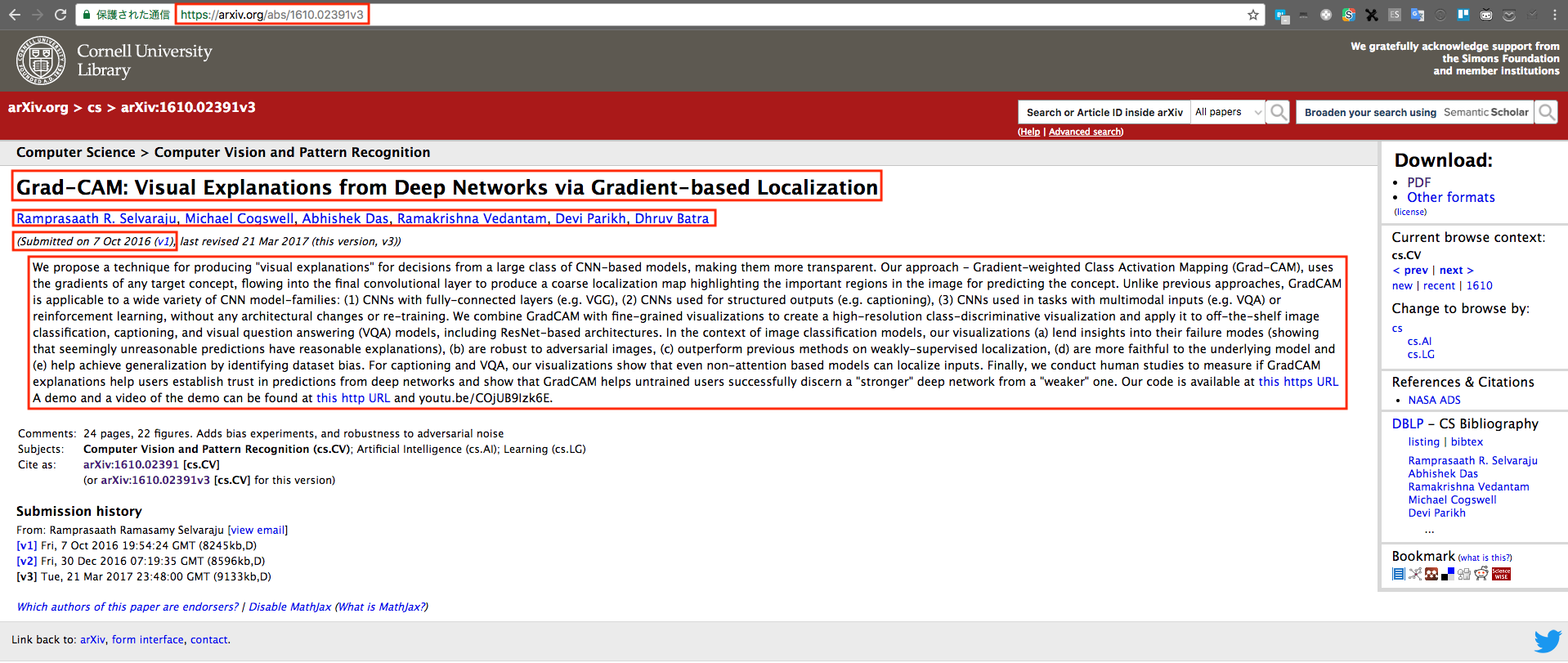arXivのAPI使いたいけどいい感じで使えそうなライブラリないかな〜と探したらありましたのでそれの紹介です。
- (2017/10/27追記)
- 実際のWEBページからどの部分を取得するのか説明する項目を追加
ライブラリ
紹介するのはこちら、Pythonのライブラリになります。
https://github.com/lukasschwab/arxiv.py
インストール
pip install arxiv
コード
例として扱う論文はこちらを利用します。
https://arxiv.org/abs/1610.02391v3
今回論文に対応しているID(1610.02391)がわかっているのでこのようにして結果を取得します。
import arxiv
# 戻り値の型はリスト
results = arxiv.query(id_list=["1610.02391"])
上記のresultには辞書フォーマットで大量の情報が格納されていますが
我々にとって必要なものは以下の5つだと思っていますので5つのみ説明します。
- PDFのURL
- 著者
- タイトル
- 投稿日
- 概要
import arxiv
results = arxiv.query(id_list=["1610.02391"])
result = results[0]
# PDFのURL
print(result.pdf_url)
# 著者
print(result.authors)
# タイトル
print(result.title)
# 投稿日
print(result.published)
# 概要
print(result.summary)
Grad-CAM: Visual Explanations from Deep Networks via Gradient-based
Localization
http://arxiv.org/pdf/1610.02391v3
2016-10-07T19:54:24Z
['Ramprasaath R. Selvaraju', 'Michael Cogswell', 'Abhishek Das', 'Ramakrishna Vedantam', 'Devi Parikh', 'Dhruv Batra']
We propose a technique for producing "visual explanations" for decisions from
a large class of CNN-based models, making them more transparent. Our approach -
Gradient-weighted Class Activation Mapping (Grad-CAM), uses the gradients of
any target concept, flowing into the final convolutional layer to produce a
coarse localization map highlighting the important regions in the image for
predicting the concept. Unlike previous approaches, GradCAM is applicable to a
wide variety of CNN model-families: (1) CNNs with fully-connected layers (e.g.
VGG), (2) CNNs used for structured outputs (e.g. captioning), (3) CNNs used in
tasks with multimodal inputs (e.g. VQA) or reinforcement learning, without any
architectural changes or re-training. We combine GradCAM with fine-grained
visualizations to create a high-resolution class-discriminative visualization
and apply it to off-the-shelf image classification, captioning, and visual
question answering (VQA) models, including ResNet-based architectures. In the
context of image classification models, our visualizations (a) lend insights
into their failure modes (showing that seemingly unreasonable predictions have
reasonable explanations), (b) are robust to adversarial images, (c) outperform
previous methods on weakly-supervised localization, (d) are more faithful to
the underlying model and (e) help achieve generalization by identifying dataset
bias. For captioning and VQA, our visualizations show that even non-attention
based models can localize inputs. Finally, we conduct human studies to measure
if GradCAM explanations help users establish trust in predictions from deep
networks and show that GradCAM helps untrained users successfully discern a
"stronger" deep network from a "weaker" one. Our code is available at
https://github.com/ramprs/grad-cam. A demo and a video of the demo can be found
at http://gradcam.cloudcv.org and youtu.be/COjUB9Izk6E.
こんな感じでそれぞれ取得できます。
IDわからない場合はどうするんだよというツッコミが聞こえてきそうですがこちらは後日追記したいと思います。
最後に
概要だけGoogle翻訳につっこんで翻訳して、Slackに投稿して興味のある論文は
しっかり読んでみるみたいなことをしたいなと考え中です。
